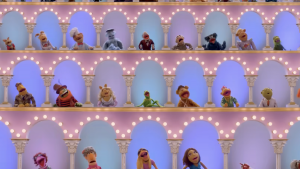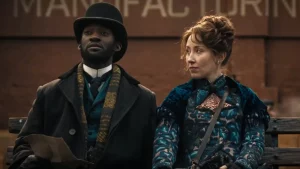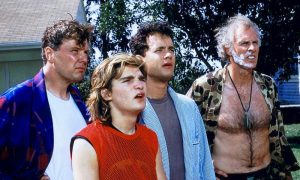
Beauty has been the focus of the film industry since the early 20th century. Ever since, we’ve seen women like Gene Tierney, Elizabeth Taylor, and Julia Roberts define and redefine the meaning of beauty and body image.
The Devil Wears Prada (2006) – Source: 20th Century Studios
While there’s little harm in watching Stanley Tucci and Anne Hathaway do their thing in beauty-focused films like The Devil Wears Prada, there’s no doubt that the industry’s fascination with beauty has reinforced unrealistic body images and has promoted standards that are tinged with sexism, ageism, racial preferences, and colonialism.
Recognizing the subtle but pervasive influence of hegemonic beauty standards is crucial for film lovers who want to free themselves of feelings of low self-worth after enjoying a flick like Pride and Prejudice. Likewise, aspiring filmmakers would do well to engage intentionally with the dialogue between the media, beauty standards, and social issues like the effects of imperialism.
The Golden Era
Dividing the film industry into “eras” is always a fraught process. But, if any period can lay claim to being the “Golden Era of Film”, it is the late 1930s through the late 1960s. During this time, films like Casablanca, Wuthering Heights, Dr. No, and Leave Her to Heaven featured actresses like Ingrid Bergman, Ursula Andress, and Gene Tierney in lead roles.
Casablanca (1942) – Source: Warner Bros. Pictures
While it’s easy to idealize the golden age of film, it’s clear that these movies had a not-so-subtle impact on our concept of beauty. First and foremost, this era of film was infamous for its ageism. Few actresses over the age of 40 landed major roles, and older women around the world felt the pressure to maintain a youthful visage.
While we may have moved on from outdated ideas of age and beauty, the issue of ageism persists in society today. Many older women still experience a disproportionate pressure to conform to body ideals compared to their male peers. Similarly, older women are often overlooked in the workplace for younger employees who are more traditionally “attractive.” These ageist ideals continue to influence stereotypes about women over the age of 50, too, and create a negative self-image in older people.
In addition to ageism, some leading women discovered that beauty standards during this era were a poisoned chalice. This was the case for Gene Tierney, who wrote in her biography, “I have always needed to believe that my career survived on more than how I looked.” In achieving this look, she realized that “a certain thinness would add attractive contours to my face.” This self-awareness points to the reality that beauty in this period was not just unattainable; it was actively harmful to those who were forced to conform to standards during their time in the spotlight.
Blockbusters
The so-called blockbuster era (1970 – late 1990s) was dominated by films that drew audiences in with promises of explosions, aliens, and icons. This era contained everything from The Godfather and Rocky to Star Wars and Top Gun. Beauty standards notably shifted during this era, too, as audiences the world over ogled bulging biceps and beach pinups.
Trying to live up to on-screen beauty standards does incur a psychological cost, but there’s little doubt that this era promoted a version of “healthy” living. Moviegoers enjoyed many a workout montage while watching Sylvester Stallone in Rocky and Jennifer Gray in Dirty Dancing.
While this may have gotten more than a few teens to sign up for their local gym, the reality is that these beauty standards were only achievable for high-profile actors who were juiced up on steroids and actresses who were taking harmful diet pills.
Though impressive, these physiques are a far cry from actual health and fitness recommendations, which suggest muscle-strengthening exercises and at least 150 to 300 minutes of exercise per week for those in their 40s. While these exercises will keep you trim, they won’t exactly make you look like a movie star. A generation of folks who would have benefited from playing sports and brisk walks may have developed body dysmorphia when comparing themselves to the stars of yesteryear.
Millenium Movies
Movies that headlined the box offices in the late 90s and early 2000s were, generally, less obsessed with explosions and high-wasted bikinis. However, that doesn’t mean beauty standards were any less pervasive. As expected, films shot in an era dominated by terms like “heroin chic” did little to advance healthy living and self-confidence.
While a decade in which Bridget Jones was fat-shamed (while weighing 136lbs) deserves all the criticism it gets, the ’00s did see a rise of filmmakers pushing back against some beauty standards. Little Miss Sunshine focuses on characters who want to be themselves (even if that means bombing at a beauty pageant) and The Sisterhood of Travelling Pants gave young women a version of body positivity while watching America Ferrera and Blake Lively share a pair of jeans that fit them all.
The Sisterhood of the Traveling Pants (2005) – Source: Warner Bros. Pictures
However, many of these critiques failed to recognize the larger undertones of colonialism, white supremacy, and capitalism that inform our understanding of beauty. Actresses like America Ferrara were an exception, as white, slender supermodel-esque actresses like Eva Green and Keira Knightley dominated the screens with portrayals of women who were at home in consumer culture.
Contemporary Commentary
Contemporary feature-length films still push beauty standards to popular audiences. However, criticism of unattainable waste lines and body shaming has improved public awareness of the perils of beauty. This has led to the long overdue rise of actors and actresses like Dolly De Leon who do not conform to white, western beauty standards.
Crucially, many of these films push back against the fetishization of folks who are typically seen as minorities in Hollywood. This is key, as representation of minorities in media is notoriously fraught. Throughout the 2010s, a third of Asian and Pacific Islander characters were linked to harmful stereotypes like the “Martial Artist,” “Model Minority”, or “Exotic Woman.” In the ‘20s, we’ve seen a widespread push-back against these stereotypes in the form of Michelle Yeoh (notably, in Everything Everywhere, All at Once) and Zendaya (who publicly called out the film industry for colorism in 2018).
Barbie (2023) – source: Warner Bros. Pictures
Beauty standards have also taken centre-stage in films like Greta Gerwig’s Barbie. While some audiences wish Barbie had gone further in its critique of capitalism and beauty standards, the surreal, uncanny representation of “The Girl Who Can Do Anything” uses Barbie’s position in society to raise social issues like patriarchy, internalized misogyny, and unrealistic beauty standards.
Conclusion:
Beauty standards have evolved dramatically since film’s inception and the early representations of body image on silver screens. While we’ve moved on from diet pills and an unhealthy obsession with beauty, there’s little doubt that the bodies we see on screen continue to influence the way we conceptualize beauty.
Rather than ignoring this reality, recent films like Barbie and The Little Mermaid have chosen to wield their power for good: critiquing the pervasive nature of Western beauty standards and giving folks around the world a blueprint for loving their own bodies. Do you think these changes are enough to dispel the power of entrenched beauty standards, or must more work be done off the screen to help folks love their own appearance?
Does content like this matter to you?
Become a Member and support film journalism. Unlock access to all of Film Inquiry`s great articles. Join a community of like-minded readers who are passionate about cinema – get access to our private members Network, give back to independent filmmakers, and more.









